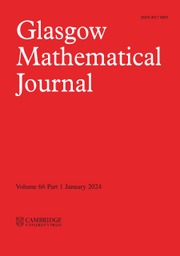Article contents
MIXED QUASI-ÉTALE QUOTIENTS WITH ARBITRARY SINGULARITIES
Published online by Cambridge University Press: 26 August 2014
Abstract
A mixed quasi-étale quotient is the quotient of the product of a curve of genus at least 2 with itself by the action of a group which exchanges the two factors and acts freely outside a finite subset. A mixed quasi-étale surface is the minimal resolution of its singularities. We produce an algorithm computing all mixed quasi-étale surfaces with given geometric genus, irregularity and self-intersection of the canonical class. We prove that all irregular mixed quasi-étale surfaces of general type are minimal. As an application, we classify all irregular mixed quasi-étale surfaces of general type with genus equal to the irregularity, and all the regular ones with K2 > 0, thus constructing new examples of surfaces of general type with χ = 1. We mention the first example of a minimal surface of general type with pg = q = 1 and Albanese fibre of genus bigger than K2.
Information
- Type
- Research Article
- Information
- Copyright
- Copyright © Glasgow Mathematical Journal Trust 2014
References
REFERENCES
- 10
- Cited by

